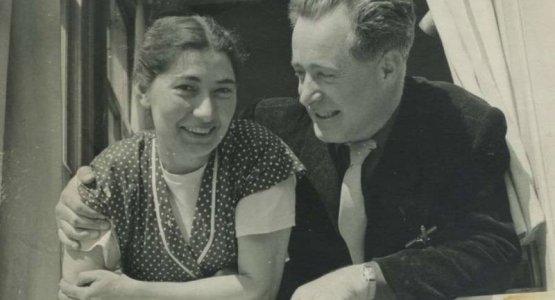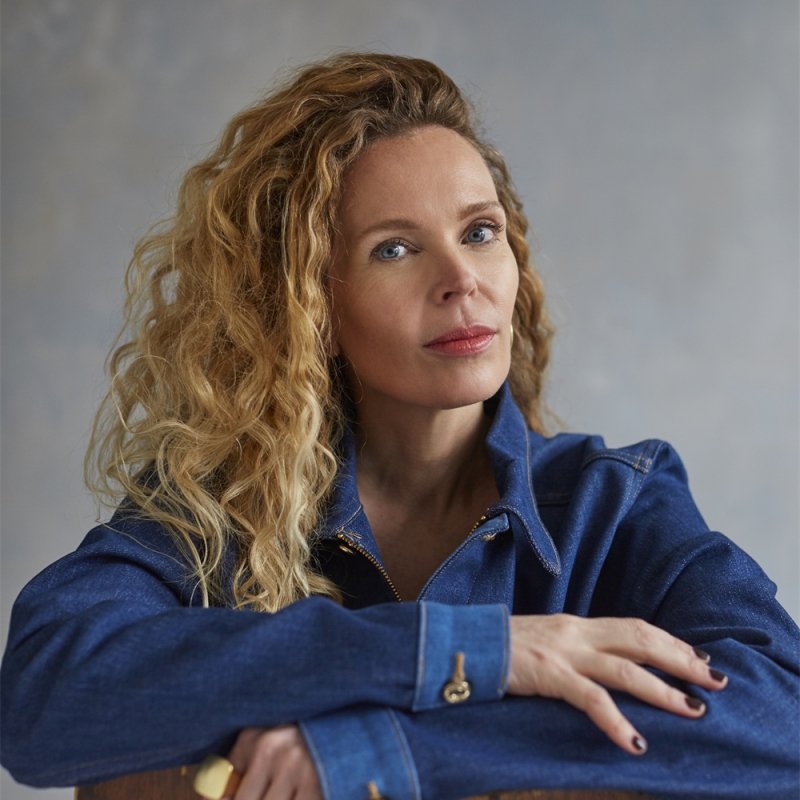Article about The High Nest published in the Volkskrant
But after you’ve read the fiction book ‘t Hooge Nest, written by its present resident, Roxane van Iperen, it’s hard to look upon the house as a fairy-tale abode. An image looms of a recalcitrant bastion in the Second World War, with accompanying roaring noise. Then you start imagining how the fearless Jewish sisters Janny (1916-2003) and Lien Brilleslijper (1912-1988) fled here in a panic and how it turned into a densely populated hideout, ‘a commune of resistance during war time’. You hear German boots clacking, Jew hunters screaming, you contemplate the suffocation and the fear of the residents, most of them ultimately being expelled to the concentration camps.
At that point you are being hit by painter/poet Armando’s notion: ‘a guilty landscape’. And the author herself knows that history is forever ‘carved into the stones of ‘t Hooge Nest.’
Roxane van Iperen (42) opens the door to her study, and is followed by here muzzled German shepherd. It’s quiet in and around ‘t Hooge Nest when she points at the location where the hatch once was, underneath the wooden floor they laid over it. That’s where the hiders kept their personal belongings. From this room they saw the Jew hunters coming. The tunnel that Jaap - Lien and Janny’s brother, who later died in Auschwitz – dug from the house to the garden was started from this position.
And it is here that Van Iperen wrote her book.
When you walk a little deeper into the woods, behind the house, you’ll find Café Bos en Hei. There in 2012, she and her boyfriend Joris, a gynaecologist by profession, were having beer and fried meatballs. The whole family (three kids, dog, cats and guinea pigs) had come from Amsterdam to Naarden and the notion of culture shock was often mentioned, as was the verb ‘move’. So, this actually was what ‘t Gooi * was like, all clichés were true, all these people pretending not to be privileged. Yikes!
*Affluent area in the centre of Holland
They would love to live a ‘Café Bos en Hei life’, sheltered by the trees, a place where you were left alone – or else they would move back to Amsterdam. So then ‘t Hooge Nest came up for sale. They had already sold their own house, when they entered this villa. Mrs Fransje Sydzes-Westerman was sitting there, a former teacher who was still involved in amateur theatre. She was unable to find a new home that quickly. To bridge the gap, the Van Iperen family allowed her to live in a spacious caravan on their lawn.
Fransje Sydzes-Westerman showed her the first pictures of the house, the way it used to be. She told her about Eberhard Rebling, Lien’s husband, and how he had come to the house in the 1980’s, to have a look down the hatch, where once were Yiddish songbooks and resistance periodicals like De Vrije Kunstenaar. Later it became clear he’d also hidden a box near the fireplace; in it were the call-up papers for military service in Germany.
What had happened here is what Van Iperen was dying to know. In the neighbourhood nobody knew a thing. Well, they had heard of ‘t Hooge Nest but its hidden history was not something people were aware of. Van Iperen explains it by arguing that ‘they weren’t local people from ‘t Gooi,’ these people living there during the war. They came from beyond, from Amsterdam and The Hague so there was no interest in them – even though ‘t Gooi had a high percentage of NSB (Dutch National Socialist Party) sympathisers.
During restoration work she stumbled upon candle stubs, resistance newspapers and sheet music, behind the walls and underneath the floor. She got to know more and more about the resistance leader Jan Hemelrijk, who stayed here, and about the ties Janny and Lien Brilleslijper had with famous artists and prominent figures from the underground movement.
Van Iperen felt that she had struck gold. A book had to be written about this and she ploughed through both domestic and foreign archives. She came into contact with relatives of the hiders, and got memoires from former residents. She realised that the true restoration of ‘t Hooge Nest was not repairing the walls but reconstructing the extraordinary events that took place between those walls.
Everything in the villa seemed to have been touched by the vague past. Was the Chinese vase located in her daughter’s room during the war or was it her son’s? As long as this particular vase was at the window, the coast was clear. If it wasn’t, then it would be a warning sign to all the resistance messengers approaching the house, or to the residents of ‘t Hooge Nest themselves.
Goddamn, she thought, when she found pictures of Janny and Lien’s children in Steven Spielberg’s Shoah archives, playing in the backyard, where her own children presently play.
Robert Brandes, Janny and Bob Brandes’ son, was one of them. The Amsterdam artist, who is now 79 years old, still has one of his father’s clocks on display in his bookcase, a clock from the war years in ’t Hooge Nest. He remembers his years there as merry ones, and not just charged, with all these people around. Last summer he paid a visit to his former hideout, at the request of Roxane. He had been there before, in the 1980’s, and in his memory it had a threatening quality, being partly situated in the woods.
Roxane van Iperen exits the villa, down to the Van Hoorn Houtsweg, close by. Eberhard Rebling had the scare of his life here when he ran into a group of German
soldiers, accompanied by an old acquaintance. And another hundred metres ahead was Anton Mussert’s hideout, where the NSB-leader took refuge after the Germans invaded in May 1940. When the Brilleslijper family moved into ‘t Hooge Nest in 1943, Mussert and his young mistress’ – a distant cousin of his wife’s - kept a love nest, not that far from them in Naarden.
Down this road here Robbie Brandes (5) was ordered to walk ahead of them to t’ Hooge Nest, to get help, while mother Jenny was taking a rest from carrying her heavy grocery bags. When he arrived at the villa he was captured by Jew hunters, it was July 1944, the beginning of the end. Brandes remembers that moment well. He hurried way before his mother. And got caught. When he thinks about that…there’s always this never vanishing, suffocating feeling.
The gate opens; Van Iperen walks back into the garden, opens the door to the villa. To her it’s a mundane activity. The fact that the house has a charged history, inescapable at that, does not affect her joy of life there. She is not hindered by bad vibes, as if the villa is still full of lost souls. When she looks outside from her bed, she mainly thinks about the people who’ve also stared dreamily through her window.
What she feels particularly is that the past puts her present into perspective, the day-to-day preoccupations. She feels honoured to be living in history. In ‘t Gooi everybody acts like they are larger than life, she feels. But hey now, take a moment to think about Janny and Lien, the Jewish resistance fighters, what they have done to help people, with all their courage. How they have suffered in Auschwitz and Bergen-Belsen. The fact that she’s allowed to live in their footsteps is why Roxane van Iperen feels like a chosen one.

